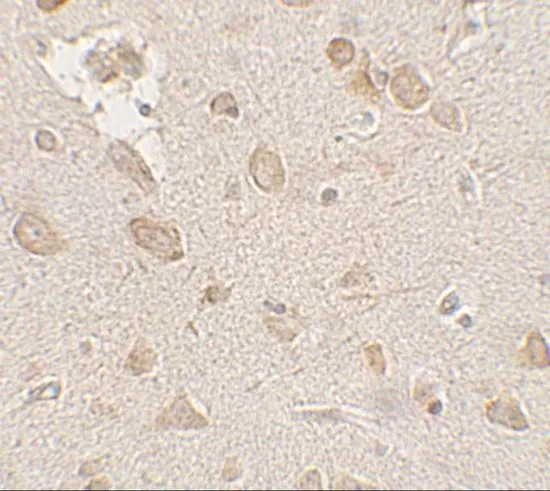
WB analysis of Kelly cell lysate using GTX88417 FMRP (aa116-130) antibody, Internal. Dilution : 0.3microg/ml Loading : 35microg protein in RIPA buffer
FMRP (aa116-130) antibody, Internal
GTX88417
ApplicationsWestern Blot, ImmunoHistoChemistry
Product group Antibodies
TargetFMR1
Overview
- SupplierGeneTex
- Product NameFMRP (aa116-130) antibody, Internal
- Delivery Days Customer7
- Application Supplier NoteWB: 0.3-1microg/ml. *Optimal dilutions/concentrations should be determined by the researcher.Not tested in other applications.
- ApplicationsWestern Blot, ImmunoHistoChemistry
- CertificationResearch Use Only
- ClonalityPolyclonal
- Concentration0.50 mg/ml
- ConjugateUnconjugated
- Gene ID2332
- Target nameFMR1
- Target descriptionfragile X messenger ribonucleoprotein 1
- Target synonymsFMRP, FRAXA, POF, POF1, fragile X messenger ribonucleoprotein 1, FMRP translational regulator 1, synaptic functional regulator FMR1
- HostGoat
- IsotypeIgG
- Protein IDQ06787
- Protein NameFragile X messenger ribonucleoprotein 1
- Scientific DescriptionThe protein encoded by this gene binds RNA and is associated with polysomes. The encoded protein may be involved in mRNA trafficking from the nucleus to the cytoplasm. A trinucleotide repeat (CGG) in the 5 UTR is normally found at 6-53 copies, but an expansion to 55-230 repeats is the cause of fragile X syndrome. Expansion of the trinucleotide repeat may also cause one form of premature ovarian failure (POF1). Multiple alternatively spliced transcript variants that encode different protein isoforms and which are located in different cellular locations have been described for this gene. [provided by RefSeq, May 2010]
- Storage Instruction-20°C or -80°C,2°C to 8°C
- UNSPSC12352203




![ICC/IF analysis of NIH3T3 cells using GTX83130 FMRP antibody [4G9]. Green : FMRP Blue: DRAQ5 fluorescent DNA dye Red: Actin filaments](https://www.genetex.com/upload/website/prouct_img/normal/GTX83130/GTX83130_20170912_ICCIF_w_23061322_959.webp)

